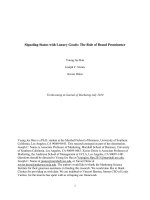The changing role of the management accountants becoming a business partner
Bạn đang xem bản rút gọn của tài liệu. Xem và tải ngay bản đầy đủ của tài liệu tại đây (2.26 MB, 178 trang )
PanidaChotiyanonandVassiliJoannidèsdeLautour
TheChangingRoleoftheManagementAccountants
BecomingaBusinessPartner
PanidaChotiyanon
Bangkok,Thailand
VassiliJoannidèsdeLautour
GrenobleÉcoledeManagement,Grenoble,France
QueenslandUniversityofTechnology,Brisbane,Australia
ISBN978-3-319-90299-9 e-ISBN978-3-319-90300-2
/>LibraryofCongressControlNumber:2018943433
©TheEditor(s)(ifapplicable)andTheAuthor(s)2018
Thisworkissubjecttocopyright.Allrightsaresolelyandexclusivelylicensedbythe
Publisher,whetherthewholeorpartofthematerialisconcerned,specificallytherightsof
translation,reprinting,reuseofillustrations,recitation,broadcasting,reproductionon
microfilmsorinanyotherphysicalway,andtransmissionorinformationstorageand
retrieval,electronicadaptation,computersoftware,orbysimilarordissimilarmethodology
nowknownorhereafterdeveloped.
Theuseofgeneraldescriptivenames,registerednames,trademarks,servicemarks,etc.in
thispublicationdoesnotimply,evenintheabsenceofaspecificstatement,thatsuchnames
areexemptfromtherelevantprotectivelawsandregulationsandthereforefreeforgeneral
use.
Thepublisher,theauthorsandtheeditorsaresafetoassumethattheadviceandinformation
inthisbookarebelievedtobetrueandaccurateatthedateofpublication.Neitherthe
publishernortheauthorsortheeditorsgiveawarranty,expressorimplied,withrespectto
thematerialcontainedhereinorforanyerrorsoromissionsthatmayhavebeenmade.The
publisherremainsneutralwithregardtojurisdictionalclaimsinpublishedmapsand
institutionalaffiliations.
ThisPalgraveMacmillanimprintispublishedbytheregisteredcompanySpringerNature
SwitzerlandAG
Theregisteredcompanyaddressis:Gewerbestrasse11,6330Cham,Switzerland
ForKhunSuchin
ListofKeyDefinitions
Keywords Descriptions
Actions
Groupofactivities
Business
partners
The“new”roleofmanagementaccountantscharacterizedbybeingbusinessoriented(GranlundandLukka1998),
havingasignificantlevelofengagementincommercialpracticesandbeingacceptedasavalue-addingmemberby
peers
Career
Aworklifehistoryofapractitioner(Bailyn1989;Barley1989),aseriesofrelatedanddefinablestagesorphases
ofagivensphereofactivitythatagroupofpeoplegoesthroughinaprogressivefashion(thatis,onestepleadsto
another)inagivendirectionoronthewaytoamoreorlessdefiniteandrecognizableendpointorgoalorseriesof
goals.(Roth1963,p.94)
Careerpath Thecourseofthecareerwithmilestonesmarkingkeyevents.
Career
turning
point
Thepointatwhichonemakesaturnanddecidestogoonadifferentpathinone’scareer
Emotions
Manifestedfeelingassociatedmostlywithshort-termgoals
End
Thelong-termgoal,thetotalityofgoalsinHeidegger’ssense(Dreyfus1991),usuallyassociatedwithmotivations
Expertise
Thecombinationofknowledgeandskill
Goals
Theshort-tointermediate-termobjectives
Knowledge Staticknowledgemostlyacquiredfromformalsourcesinsideandoutsidetheworkplaces(suchasschools)
Know-how Thepartofthestaticknowledgethatisacquiredfromworkplaces,suchascorporatefinancialpolicyandmanuals
Orientation Stateoforienting
Orienting
Performingactionsgearedtowardaspecificgoal/end
Skill/know- Knowledgeinaction:theabilitytoapplyacquiredknowledgeandknow-howtoworkinvariouscontexts,the
how-to
equivalentofSchatzki’spracticalunderstanding
Worklife
profile
Theprofileofworklifeinchronologicalorder
References
Bailyn,L.(1989).Understandingindividualexperienceatwork:Commentsonthetheoryand
practiceofcareers.InM.Arthur,D.Hall,&B.Lawrence(Eds.),Handbookofcareertheory(pp.
477–489).Cambridge:CambridgeUniversityPress.
Barley,S.(1989).Careers,identities,andinstitutions:ThelegacyoftheChicagoSchoolof
Sociology.InM.Arthur,D.Hall,&B.Lawrence(Eds.),Handbookofcareertheory(pp.41–65).
Cambridge:CambridgeUniversityPress.
Dreyfus,H.(1991).Being-in-the-world.AcommentaryonHeidegger’sbeingandtime,division
I.Cambridge,MA:TheMITPress.
Granlund,M.,&Lukka,K.(1998).Towardsincreasingbusinessorientation:Finnish
managementaccountantsinachangingculturalcontext.ManagementAccountingResearch,9
,185–211.
Roth,J.A.(1963).Timetables:Structuringthepassageoftimeinhospitaltreatmentand
othercareers.Indianapolis:Bobbs-Merrill.
Acknowledgment
Thisbookoriginatesfromapractitioner’scuriosityassociatedwiththecareerdevelopment
ofmanagementaccountantsandtheimplicationsofthisforthefuturecareersoffinance
practitionersingeneral.Itevolvedintoafive-yearresearchcollaborationprojectentailinga
longbutfruitfuljourney,andhasresultedinrichandprofoundinsightthatisbeneficialto
boththeacademicandprofessionalcommunitiesalike.Intheprocesswewouldliketothank
ValerieSabatierandtheexcellentDBAprogramteamoftheGrenobleEcoledeManagement
forprojectsupport,DamonGolsorkhi,LukasGoretzki,andthelateBernardGumbfor
invaluablecommentsandinsights,andAnekJandrakholigaandManeshkaMahtanifortheir
valuableinsightsandsupportcontributingtothesuccessoftheresearchproject.Lastbutnot
least,wewouldliketothankourfamilies,especiallySuchinChotiyanonandRachaelde
Lautour,fornurturingourpassionandjoy,andprovidingcontinuoussupportinourquestfor
knowledge.
February8,2018
PanidaChotiyanon
VassiliJoannidèsdeLautour
Introduction
Thisbookisabouttheself-orientingprocessofmanagementaccountants,keytotheir
emergingnewroleasbusinesspartners.Contemporaryprofessionalandacademicliteratures
haveinformedofthesignificantchangeintheroleofmanagementaccountantssincethe
early1990s.Fromthetraditionalroleof“bookkeepers”(Beard1994;Bougen1994;Friedman
andLyne2001;DimnikandFelton2006;Jeacle2008;Chenetal.2012),theyhavegrown
increasingly“business-oriented”(GranlundandLukka1998),becoming“businesspartners”
(Järvenpää2007).Ineverydaypracticethenewbusiness-orientedroletakesvariousshapes,
beingspecifictolocalsitesandassociatedbusinesscontexts(Ahrens1996,1997;Ahrensand
Chapman2002,2007;JørgensenandMessner,2010;FauréandRouleau2011;Moralesand
Lambert2013;NamaandLowe2014;Janin2016).Weseethenewbreedofmanagement
accountantsasbeingactiveoutsidetheirtraditionaldomaininareasthatwouldpreviously
havebeenunthinkable,suchashelpingthesalesmanagerdecidehowtocounter-offerasales
promotionalcampaignorsolvingthesalesdiscountstructureissuewithasalesman(Ahrens
1997),workingwithbuyerstodecideonthenewmenufortherestaurantmanagers(Ahrens
andChapman2007),actingasagatekeeperingrantingloanstocustomers(Ahrens1997),
settingfinancialthresholdsfortheapprovalofnewproductdevelopment(Jørgensenand
Messner2010),assistinginthesupplychainprocessofprivateequityfundmanagement
(NamaandLowe2014),helpingmiddlemanagersinthebudgetingprocess(Ahrens1996,
FauréandRouleau2011),orevenadvisingafootballclubindealingwiththeFootball
Association’srules(Janin2016).Althoughthenewroleisprevalentinvariousorganizations
acrossindustriesworldwide,establishingsucharoleinanorganizationisnota
straightforwardmatter.Sofar,managementaccountingresearchhasshedlightonhowthe
externalelementssuchasthesociopoliticalandeconomicforces,thechangeinthe
organization,andtheagencyofkeyorganizationalplayerscaninfluencetheestablishingof
thenewroleintheorganization.Nevertheless,itisfoundthatnotallmanagement
accountantsareorientingtowardbusiness.Someofthemarefoundtohave“irreconcilable”
roleorientationtowardthenarroweraccountingrole,whileothersareorientedtowarda
broader“businesspartnering”role(Järvenpää2007;FriedmanandLyne1997;Burnsand
Baldvinsdottir2005;ByrneandPierce2007).Thisindicatestheimportanceofunderstanding
theprocessthroughwhichthemanagementaccountants“internalize”thenewrole,anarea
whichwestillhavelittleknowledgeabout(Goretzkietal.2013;Guo2017).
Thisbooktakesitsreadersalongajourneyintimethatexploresthediverseworklife
experiencesoffinancepractitioners.Forthefirsttimeitprovidesadeepinsightintohowand
whymanagementaccountantsorienttowardbusinessinordertobecomebusinesspartners.
Usingauniqueresearchmethodinfluencedbytheoralhistorytraditioncoupledwiththedata
analysisofStraussandCorbin(1998),wemobilizeSchatzki’snotionsofteleoaffective
structureandpracticememory(Schatzki2002,2006)tomakesenseofthenarrativesoffour
financepractitionersfromdifferentcareertracksandconceptualizetheBusinessPartner
DevelopingModel(BPDM).Thismodelhelpstoexplainhowmanagementaccountants
becomebusinesspartnersthroughtheirlifelongself-orientingprocesses,oneofthemost
importantaspectsofthechangingroleofmanagementaccountants.Forthefirsttime,
readerswillgainnotonlyadeepinsightintotheentireworklivesofmanagement
accountantsbutalsoanunderstandingofhowandwhyeachofthemhascopedwith
continuouslychangingworkcontextsandgraduallybecometherelevantbusinesspartner.
Althoughthebookisaimedprimarilyatfuturemanagementaccountantswhoare
embarkingonbuildingacareerinmanagementaccounting,managementcontemplatingon
establishingthenewrolewithintheirorganizations,financeeducatorsdesigningthe
programcurriculum,andthefinancecommunityingeneral,wehopethatourunique
longitudinalapproachandtheBPDMthatwehavedevelopedwillbebeneficialinhelping
researchonthepractitionersinotherpractices,thatareasequallydiverseasmanagement
accounting,therebyenrichingourknowledgeinthebroaderareaofsociologyofprofession.
Thebookisorganizedintothreeparts.PartIprovidesthebackgroundfortheemergence
ofthenewroleofmanagementaccountantsandtheirself-orientingprocesses.Webeginin
Chap.1bylookingatthephenomenonofthenewrolefromthreeperspectives:themacrolevel,concerningthesociopoliticalandeconomicenvironment,themeso-level,concerning
theorganizationalchange,andthemicro-level,focusingontheagencyofthekey
organizationalplayersinordertoidentifythekeydriversofthechange.Intheprocesswe
haveidentifiedmanagementaccountants’self-orientingprocessasoneofthemostimportant
aspectsoftheirchangingrole.Inordertogainabetterunderstandingabouttheprocesswe
reviewthecontemporarytheoreticalapproachestotheself-orientingprocessinChap.2,and
highlighttheadvantagesofSchatzki’spracticetheoryanditsnotionofteleoaffective
structureandpracticememory(Schatzki2002,2006)inmakingsenseofthelifelongselforientingprocessofmanagementaccountants.Next,inChap.3,wemobilizeSchatzki’s
frameworktotheorizetheBPDM,aproductofourresearchproject,1whichexplainsthe
phenomenonofbecomingbusinesspartnersthroughthelifelongself-orientingprocessof
managementaccountants.Themodelisbuiltonthreemicro-processes,consistingofthe
associatedpurposefulactionsofmanagementaccountantsalignedtowardbecoming
businesspartners,togetherwiththeunderlyingkeynotionofthecareerturningpoint,andit
iscapableofexplainingnotonlythelifelongself-orientingprocessbutmostimportantlythe
variationinthedegreeofbusinessorientationfoundineverydaypracticesaswell.
InPartIIweusetheBPDMtolookatthereal-lifeexperiencesofmanagementaccountants
intheirlifelongself-orientingprocesses.Fromfourdiversecareertracksweprovideadeep
insightandunderstandingintohowandwhyeachofthefourselectedfinancepractitioners
graduallyorientstowardbusinesstobecomewhohe/sheisatpresent.WebegininChap.4
withthenarrativeofCarolasshenavigatesthecourseofhercareerincorporatefinancial
service,beginningasanauditapprenticeandbecomingafinancemanager,aligningshorttermpersonalobjectivestothelong-termendwithafewsignificantturningpointsonthe
way.FollowingsuitinChap.5isthestoryofAnne,whoisonthefinancialplanningand
analysiscareertrack.Herlifelongself-orientingprocesstakesherfromafinancialapprentice
toanexpertinfinancialplanningandanalysis,uptothepointwhereshehastomakeoneof
themostimportantdecisionsinherworklife.InChap.6welookatMadelyn’scareerin
commercialfinance.Frombeingacontrollerina“mundane”chemicalindustrytoher
appointmentasthecommercialdirectorofanexcitingbutchallengingfast-movingconsumer
goodsindustry,shemaneuversthroughthedrasticchangesinthebusinesscontexts,
becomingincreasinglybusinessorientedandbeingacceptedasatruebusinesspartnerbyall
herpeers.InChap.7wefollowAlain’smanagementcontrolcareer.Withoutanypriorrelevant
backgroundinbusiness,weseehowhislifelongself-orientingprocessisinfluencedbythe
changingmanagementphilosophyandbusinesscontexts;howhisroleisextendedbeyond
businesspartnertobecomethechangeagent;howcorporatecultureinfluenceshiscourseof
actions;andhowhiscourseofactionsinturncontributestoanewcorporateculture.
InPartIII,learningfromthesereal-lifeexperiences,wemobilizetheBPDMandproposean
internalcareerdevelopmentprograminChap.8.Thisisaimedathelpingtopreparefuture
managementaccountantsforthechallengesthatcomewiththecontinuouslychanging
businessenvironment.
ThebookcloseswiththeconcludingChap.9,inwhichwediscussthekeypointsrelatedto
thelifelongself-learningprocessofmanagementaccountants,oneofthemostimportant
aspectsoftheirchangingrole,andourcontributionstoknowledgeinempirical,theoretical,
managerial,andmethodologicalterms,togetherwiththeimplications.
References
Ahrens,T.(1996).Stylesofaccountability.Accounting,OrganizationsandSociety,21(2–3),
139–173.
Ahrens,T.(1997).Talkingaccounting:Anethnographyofmanagementknowledgein
BritishandGermanbrewers.Accounting,OrganizationsandSociety,22(7),617–637.
Ahrens,T.,&Chapman,C.S.(2002).Thestructurationoflegitimateperformancemeasures
andmanagement:Day-to-daycontestsofaccountabilityinaU.K.restaurantchain.
ManagementAccountingResearch,13(2),151–171.
Ahrens,T.,&Chapman,C.S.(2007).Managementaccountingaspractice.Accounting,
OrganizationsandSociety,32(1–2),1–27.
Beard,V.(1994).Popularcultureandprofessionalidentity:Accountantsinthemovies.
AccountingOrganizationsandSociety,19(3),303–318.
Bougen,P.D.(1994).Jokingapart:Theserioussidetotheaccountingstereotypes.
AccountingOrganizationandSociety,19(3),319–335.
Byrne,S.,&Pierce,B.(2007).Towardsamorecomprehensiveunderstandingoftheroles
ofmanagementaccountants.EuropeanAccountingReview,16(3),469–498.
Burns,J.,&Baldvinsdottir,G.(2005).Aninstitutionalperspectiveofaccountants’new
roles–Theinterplayofcontradictionsandpraxis.EuropeanAccountingReview,14(4),725–
757.
Chen,C.C.,Jones,K.T.,Scarlata,A.N.,&Stone,D.N.(2012).DoestheHollandmodelof
occupationalchoice(HMOC)perpetuatetheBeancounter-Bookkeeper(BB)stereotypeof
accountants?CriticalPerspectivesonAccounting,23(4–5),370–389.
Dimnik,T.,&Felton,S.(2006).AccountantstereotypesinmoviesdistributedinNorth
Americainthetwentiethcentury.AccountingOrganizationsandSociety,31(2),129–155.
Fauré,B.,&Rouleau,L.(2011).Thestrategiccompetenceofaccountantsandmiddle
managersinbudgetmaking.Accounting,OrganizationsandSociety,36,167–182.
Friedman,A.L.,&Lyne,S.R.(1997).Activity-basedtechniquesandthedeathofthe
beancounter.EuropeanAccountingReview,6(1),19–44.
Friedman,A.L.,&Lyne,S.R.(2001).Thebeancounterstereotype:Towardsageneral
modelofstereotypegeneration.CriticalPerspectivesonAccounting,12(4),423–451.
Goretzki,L.,Strauss,E.,&Weber,J.(2013).Aninstitutionalperspectiveonthechangesin
managementaccountants’professionalrole.ManagementAccountingResearch,24,41–63.
Granlund,M.,&Lukka,K.(1998).Towardsincreasingbusinessorientation:Finnish
managementaccountantsinachangingculturalcontext.ManagementAccountingResearch,9
,185–211.
Guo.(2017).Theodysseyofbecoming:Professionalidentityandinsecurityinthe
Canadianaccountingfield.CriticalPerspectivesonAccounting.https://doi.org/10.1016/j.cpa.
2017.10.008.
Janin,F.(2016).Whenbeingapartnermeansmore:Theexternalroleoffootballclub
managementaccountants.ManagementAccountingResearch.https://doi.org/10.1016/j.mar.
2016.05.002.
Järvenpää,M.(2007).Makingbusinesspartners:Acasestudyonhowmanagement
accountingculturewaschanged.TheEuropeanAccountingReview,16(1),99–142.
Jeacle,I.(2008).Beyondtheboringgrey:Theconstructionofthecolourfulaccountant.
CriticalPerspectivesonAccounting,19(8),1296–1320.
Jørgensen,B.,&Messner,M.(2010).Accountingandstrategising:Acasestudyfromnew
productdevelopment.Accounting,Organizations&Society,35(2),184–204.
Morales,J.,&Lambert,C.(2013).Dirtyworkandtheconstructionofidentity.An
ethnographicstudyofmanagementaccountingpractices.Accounting,Organizationsand
Society,38,228–244.
Nama,Y.,&Lowe,A.(2014).The‘situatedfunctionality’ofaccountinginprivateequity
practices:Asocial‘site’analysis.ManagementAccountingResearch,25,284–303.
Schatzki,T.R.(2002).Thesiteofthesocial:Aphilosophicalaccountoftheconstitutionof
sociallifeandchange.UniversityPark:PennsylvaniaStateUniversityPress.
Schatzki,T.R.(2006).Onorganizationsastheyhappen.OrganizationStudies,27(12),
1863–1187.
Strauss,A.L.,&Corbin,J.M.(1998).Basicsofqualitativeresearch:Techniquesand
proceduresfordevelopinggroundedtheory.ThousandOaks:Sage.
Contents
PartI TheEmergingNewRoleandtheSelf-OrientingProcess
1TheEmergenceofBusiness-OrientedRole
1.1TheEmergenceoftheBusiness-OrientedRoleofManagementAccountants
1.1.1SociopoliticalandEconomicInfluences
1.1.2OrganizationalChanges
1.1.3TheAgentiveForce
1.2BusinessOrientationofManagementAccountants
1.2.1GeneralSelf-OrientingStrategies
1.2.2Self-OrientationinEverydayLife
1.2.3Self-OrientinginCulturalContext
1.2.4Self-Orienting,Culture,andPastPractices
1.2.5Self-OrientingasaLifeJourney
References
2Self-OrientingProcessandSchatzki’sLens
2.1TheTurntoPractices
2.1.1InstitutionalTheoryStudy
2.1.2FoucauldianStudy
2.1.3TheActorNetworkTheoryStudy
2.1.4Bourdieu’sPracticeTheoryStudy
2.1.5Giddens’StructurationTheoryStudy
2.2TakingStock
2.3Schatzki’sPracticeTheory
2.3.1Practicesasthe“SiteofSocial”
2.3.2PracticesPerpetuatingThroughVariations
2.3.3PracticeMemoryLinkingActivitiesAcrossTime
2.3.4Self-Orienting,TeleoaffectiveStructuresOrchestrating
2.3.5Self-Orienting,TeleoaffectiveStructure,PracticeMemory,CulturalMemory
References
3BusinessPartnerDevelopingModel(BPDM)
3.1ConceptualizetheSelf-OrientingProcess
3.1.1BecomingaFinanceApprentice
3.1.2BecomingaFinanceExpert
3.1.3BecomingaBusinessPartner
3.2Self-OrientingProcess,TeleoaffectiveStructure
3.3The“TurningPoint”andAffectivity
3.4Self-Orienting,OrganizationalandCulturalContext,PastPractice,andAffectivity
3.5Self-OrientingStudy,theLongitudinalApproach
References
PartII Self-OrientingProcess:TheLifelongExperiences
4CorporateFinancialServicesCareer
4.1BecomingaCPA(2002–2005)
4.1.1AcquiringTechnicalKnowledge
4.1.2AcquiringPracticalKnow-HowandUnderstanding
4.2BecomingtheFinancialAnalyst(2008–2010)
4.2.1AcquiringPracticalKnowHowandUnderstanding
4.3BecomingaCategoryAnalysisManager(2011–2014)
4.3.1AcquiringAdditionalPracticalKnow-How
4.3.2AcquiringPracticalUnderstandingThroughSharingthePractice
4.3.3EngaginginCommercialPractices
4.4BecomingIndochinaFinanceManager(2015)
4.4.1SharingthePractices,AcquiringAdditionalPracticalKnow-How
4.5TheLifelongSelf-OrientingProcess
4.5.1Self-OrientingProcess,TeleoaffectiveStructure
4.5.2Self-Orienting,PersonalCharacteristics,andAffectivity
4.5.3Self-Orienting,theCulturalContext,andAffectivity
References
5FinancialPlanningandAnalysisCareer
5.1BecomingaCreditAssistant(2002–2006)
5.1.1AcquiringPracticalKnow-HowandUnderstanding
5.1.2AcquiringAdditionalPracticalUnderstanding
5.2BecomingaCreditAssessmentandControlAssistant(2009)
5.2.1AcquiringAdditionalTechnicalKnowledge,SharingthePractice,and
GainingAdditionalPracticalUnderstanding
5.3BecomingaCategoryAnalysisManager(2010–2012)
5.3.1AcquiringPracticalKnow-How,SharingthePractice,andAcquiringPractical
Understanding
5.3.2SharingthePractice,AcquiringAdditionalPracticalUnderstanding
5.4BecomingFinancialPlanningandAnalysisManager(2013–Present)
5.4.1EngaginginOtherPractices,AcquiringAdditionalPracticalUnderstanding
5.4.2SharingthePractice
5.5TheLifelongSelf-OrientingProcess
5.5.1Self-OrientingProcess,TeleoaffectiveStructure
5.5.2Self-Orienting,PersonalCharacteristics,andAffectivities
5.5.3Self-Orienting,theCulturalContext,andAffectivity
6CommercialFinanceCareer
6.1BecomingaController(1990–1999)
6.1.1AcquiringPracticalKnow-HowandPracticalUnderstanding
6.2BecomingaBudgetManager(2000–2006)
6.2.1SharingthePractice,AcquiringPracticalUnderstanding
6.2.2EngaginginCommercialPractice,CreatingValue
6.3BecomingAssociatedDirector-CommercialFinance(2007–2012)
6.3.1EngaginginCommercialPractice,AcquiringAdditionalPractical
Understanding
6.3.2SharingPractice,CreatingValue
6.4BecomingCommercialFinanceDirector,Asia(2013–Present)
6.4.1SharingthePractice,CreatingValue
6.4.2EngaginginCommercialPractice,CreatingAdditionalValue
6.5TheLifelongSelf-OrientingProcess
6.5.1Self-OrientingProcess,TeleoaffectiveStructure
6.5.2Self-Orienting,PersonalCharacteristics,andAffectivity
6.5.3Self-Orienting,CulturalContext,andAffectivity
References
7ManagementControlCareer
7.1BecomingaPlanningManager(1973–1975)
7.1.1AcquiringTechnicalKnowledge
7.1.2AcquiringPracticalUnderstanding
7.1.3CreatingValue
7.2BecomingFinanceandAccountManager(1976–1978)
7.2.1EngaginginOtherPractices,GainingAdditionalPracticalUnderstanding
7.2.2SharingthePractice,CreatingValue
7.3BecomingDeputyAdministrationManager(1979–1981)
7.3.1SharingthePractice,BuildingonPracticalUnderstanding
7.3.2EngaginginOtherPractices,CreatingValue
7.4BecomingCentralExecutiveCoordinatingOffice(CECO)Director(1982–1997)
7.4.1SharingthePractice,BuildingonPracticalUnderstanding
7.4.2EngaginginOtherPractices,CreatingValue
7.5TheLifelongSelf-OrientingProcess
7.5.1Self-Orienting,TeleoaffectiveStructure
7.5.2Self-Orienting,PersonalCharacteristics,andAffectivity
7.5.3Self-Orienting,CulturalContext,andAffectivity
References
PartIII CraftinganOrientationProgram
8BusinessPartnerDevelopmentProgram
8.1TheCrucialRoleoftheMentorandtheSponsor
8.2PlanningandExecutingoftheCareerDevelopmentProgram
8.2.1Pre-managerialStage
8.2.2ManagerialStage
8.2.3Post-managerialStage
8.3ManagementConsiderationandChallenges
References
9Conclusion
References
References
Index
BriefContents
PartITheEmergingNewRoleandtheSelf-OrientingProcess
Chapter1TheEmergenceofBusiness-OrientedRole
Chapter2Self-OrientingProcessandSchatzki’sLens
Chapter3BusinessPartnerDevelopingModel(BPDM)
PartIISelf-OrientingProcess:TheLifelongExperiences
Chapter4CorporateFinancialServicesCareer
Chapter5FinancialPlanningandAnalysisCareer
Chapter6CommercialFinanceCareer
Chapter7ManagementControlCareer
PartIIICraftinganOrientationProgram
Chapter8BusinessPartnerDevelopmentProgram
Chapter9Conclusion
ListofFigures
Fig.3.1BusinessPartnerDevelopmentModel(BPDM)
Fig.3.2Turningpointsincareer
Fig.3.3Worklifeprofile
Fig.4.1Self-orientingprocessandgoalaligning–corporatefinancialservicemanager
Fig.4.2Turningpoint–corporatefinancialservicemanager
Fig.5.1Self-orientingprocessandgoalaligning–financialplanningandanalysismanager
Fig.5.2Turningpoint—financialplanningandanalysismanager
Fig.6.1Self-orientingprocess,commercialfinancedirector
Fig.6.2Turningpoint:Asiancommercialfinancedirector
Fig.7.1Self-orientingprocessandgoalaligning-CECOdirector
Fig.7.2Turningpoint–CECOdirector
Fig.8.1Levelofengagementinpracticesandcareerchoices
ListofTables
Table2.1Comparativetheoreticallens
Table2.2Comparativetheoreticallenses-extended
Table3.1Teleoaffectivestructuresunderlyingtheself-orientingprocess
Table3.2Profilesoftheselectedfinancialpractitioners
Table4.1Listofactionsandkeymilestonesofthecorporatefinancialservicecareer
Table4.2Self-orientingandteleoaffectivestructure–corporatefinancialservicemanager
Table5.1Listofactionsandkeymilestonesoffinancialplanningandanalysiscareer
Table5.2Self-orientingandteleoaffectivestructure–financialplanningandanalysismanager
Table6.1Listofactionsandkeymilestonesofcommercialfinancecareer
Table6.2Self-orientingandteleoaffectivestructure–commercialfinancedirector
Table7.1Listofactionsandkeymilestonesofthemanagementcontrolcareer
Table7.2Self-orientingandteleoaffectivestructure–CECOdirector
Table8.1Businesspartnerdevelopmentprogram
Footnotes
1 Chotiyanon,P.(2018).BecomingaBusinessPartner,alifelongself-orientingprocess.(Doctoraldissertation)GrenobleEcole
deManagement,Grenoble,France.
PartI
TheEmergingNewRoleandtheSelf-Orienting
Process
©TheAuthor(s)2018
PanidaChotiyanonandVassiliJoannidèsdeLautour,TheChangingRoleoftheManagementAccountants
/>
1.TheEmergenceofBusiness-OrientedRole
PanidaChotiyanon1 andVassiliJoannidèsdeLautour2,3
(1) Bangkok,Thailand
(2) GrenobleÉcoledeManagement,Grenoble,France
(3) QueenslandUniversityofTechnology,Brisbane,Australia
Contemporarymanagementaccountingresearchinformsusoftherecentemergenceofthe
newroleofmanagementaccountants.Fromthetraditionalroleof“bookkeepers”theyhave
becomemore“business-oriented”(GranlundandLukka1998)moreofa“businesspartner”
type(Järvenpää2007;Beard1994;Bougen1994;FriedmanandLyne2001;Dimnikand
Felton2006;Jeacle2008;Chenetal.2012).Ineverydaypractice,thenewbusiness-oriented
roletakesvariousshapes,beingspecifictolocalcontexts(Ahrens1996,1997;Ahrensand
Chapman2002,2007;JørgensenandMessner2010;FauréandRouleau2011;Moralesand
Lambert2013;NamaandLowe2014;Janin2016).Managementaccountingresearchhas
suggestedafewkeydriversthathavecontributedtotheemergenceofthisnewroleovertime
(ByrneandPierce2007).Onthemacro-level,therearethebroadchangesinthesociopolitical
environmentandeconomicforces(Loft1986;MillerandO’Leary1987;BerlandandChiapello
2009).Withintheorganizationthenewrolehasbeenassociatedwiththechangesin
corporateculture,broaderorganizationrestructuring,andgeneralchangesinmanagement
philosophy(Simonetal.1954;GranlundandLukka1998;AhrensandChapman2002;Burns
andBaldvinsdottir2005;Järvenpää2007;Nor-AziahandScapens2007;AhrensandMollona
2007;LambertandPezet2011;LambertandSponem2012;Goretzkietal.2013).Atthe
micro-level,significancehasbeenplacedontheagencyofkeyplayers,suchastheleadersof
organizationsandinparticulartheleadersofthefinancefunctions(HopperandMacintosh
1993;Chua1995;BriersandChua2001;BurnsandBaldvinsdottir2005;BaxterandChua
2008;Goretzkietal.2013),theoperationalmanagers(Hopper1980;Windecketal.2015),as
wellasthemanagementaccountantsthemselves(ByrneandPierce2007;Goretzkietal.2013;
MoralesandLambert2013;Janin2016;Guo2017).
Beingbusinessoriented(GranlundandLukka1998;AhrensandChapman2000;Burnsand
Baldvinsdottir2005;ByrneandPierce2007;Goretzkietal.2013)fortoday’smanagement
accountantsmeansplacinganincreasingemphasisonamorestrategic,forward-looking,and
collaborativeroleorientation(GranlundandLukka1998;BurnsandBaldvinsdottir2005;
ByrneandPierce2007).However,becomingbusinessorientedmightnotbestraightforward.
Ithasbeenfoundthatnotallmanagementaccountantsareorientingtowardbusiness.Some
ofthemarefoundtohave“irreconcilable”roleorientationtowardthenarroweraccounting
role,whiletheothersareorientedtowardabroader“businesspartnering”(Järvenpää2007;
FriedmanandLyne1997;BurnsandBaldvinsdottir2005;ByrneandPierce2007).This
indicatestheimportanceofunderstandingtheprocessthroughwhichmanagement
accountantsinternalizetheirnewrole,anareaaboutwhichwestillhavelittleknowledge
(Goretzkietal.2013;Guo2017).
1.1 TheEmergenceoftheBusiness-OrientedRoleof
ManagementAccountants
Therealmofmanagementaccountants’activitieshasbeeninternallyorientedtowardtheir
internalclients,forexamplethegeneralmanagers,productionmanagers,andsalesmanagers;
providingsupportin“scorekeeping,”thatis,traditionalperformancerecordkeepingand
producingperiodicfinancialreportssuchasbudgetandactualnumbers;“attention
directing,”suchasperformingvarianceanalysis,and“problem-solving”orinternal
consulting,intermsofpreparingspecialfinancialanalysestoaidindecision-making—such
aswhethertoinvestinaparticularmachineornot(Simonetal.1954).Theseactivitiescan
alsobebroadlycategorizedas“controlling”(scorekeepingandattentiondirecting),whichis
detachedfromthebusiness,and“consulting”(problem-solving),whichismoreoriented
towardthebusiness,asmanagementaccountantsalignthemselvesmorewiththeoperating
managers(Mouritsen1996;Ahrens1996,1997).Insomecasestherealmofactivitieshas
broadenedtoincludespecializedfinancialareasofbanking,internationalcashmanagement,
capitalstructure,andadministration,withdirectinvolvementincustomercreditand
suppliers’relationshipsaswell.Managementaccountingresearchhasattributedthese
developmentsmainlytobroadsociopoliticalandeconomicforces,organizationalchanges,
andtheagencyofkeyorganizationalplayers.
1.1.1 SociopoliticalandEconomicInfluences
Themanagementaccountants’roleorientationhasbeenassociatedwiththebroader
developmentinthesociopoliticalsituation.Forexample,ithasbeensuggestedthat
managementaccountingpracticesuchasbudgetingemergedoutofconcernforthefailureof
capitalismduringthe1930sto1950s,whichcausedmajoreconomicproblemssuchas
unemploymentafterthetwoworldwars.Insteadofgoingbacktothepriorsystem,which
favoredtheprivilegedfew—theowners,ratherthantheemployees—socialreformers
decidedto“fix”capitalismbyimplementingbudgetcontrolsystems,responsibility
accounting,andmanagementbyobjectives,whichenabledtheemployeestosharewealth
withtheowners.Inthiscontextofthenew“spiritofcapitalism”(BerlandandChiapello
2009),managementaccountingpracticeemergednotjustasacalculativepracticebutalsoas
adisciplinarypractice(Loft1986;MillerandO’Leary1987),withmanagementaccountants
tendingtoorienthierarchicallytowardtopmanagementtohelpintheprocessofmonitoring
andcontrollingastheyworkedtowardtheoverallcorporategoals(HopperandMacintosh
1993).
1.1.2 OrganizationalChanges
Thewaveofeconomicforcesduringthe1980sand1990saffectedcorporatecultureand
managementphilosophyinsuchawaythatitledtobroadorganizationrestructuring,which
inturnprovidedanopportunityforthegeneralincreaseinbusinessorientationof
managementaccountants(GranlundandLukka1998;Järvenpää2007).Duringthisperiodbig
companiesexpandedtheiroperationsacrossnationalbordersandbecameinternationalized
orglobalized.Facedwithfiercercompetitionathomeandabroad,managementsshiftedtheir
attentiontowardcustomersandcostmanagement.Inthebeginningthisdevelopmentledto
decentralizationofformerlycentralizedfunctions,suchasproduction,sales,andfinance,to
accommodatethehigherneedforcontrolandcooperationamongdispersedunitsof
operationthatspannednationalborders.Managementaccountants’teamswerealso
reorganizedintothosewhowerelocatedcentrally,performingtraditionalbookkeepingand
preparingreports,andthoselocatedwithinthedispersedoperatingunitstowatchoverthe
company’swell-being,takingpartinmanagementdecision-makingandbecomingadvisors
andsometimeschangeagents.Thislattergroupoflocalizedmanagementaccountantswas
characterizedasbeing“businessoriented”;thatis,placingmoreemphasisonthefutureand
strategicimperatives,forexamplebyusingfinancialforecastorestimatesforstrategic
decision-makingratherthanbeingconcernedabouttheaccuracyofthepastdataastheir
colleaguesatthecorporatecenterwere;beinggoodatcross-boundarycollaborationand
comfortablecommunicatingacrossfunctionallinestocoordinateactivitieswithinthe
dispersedunitsaswellasatthecentralizedunitwheretheyfunctionallybelonged(Granlund
andLukka1998).
Globalizationandtherapidlychangingmarketssituationduringthe1990sprovideda
backdropfromwhichanewbusiness-orientedroleofbusinesspartner(Järvenpää2007)
emerged.Forexample,inthetelecommunicationindustry,deregulationcoupledwithnew
technologiesandthenewkindofservicesavailableintheindustryforcedaFinnishglobal
leaderintelecommunicationbusinesstofocusmoreonthecustomerdimensionofthe
business,providinganopportunityforthemanagementaccountantstotakeupthenewrole
ofbusinesspartners.Thebusinessorientationinthiscompanyevolvedovertheperiodoften
yearsfrom1992to2001alongwithabroadorganizationalrestructuring,whichledtoa
continuousimprovementculturethatwassharedwithinthecompany.Thisnewcustomerorientedphilosophyputpressureonmanagementaccountantstobemoreinlinewiththe
newcustomerfocus.Thechangebeganwiththedecentralizationofcontrollingfunctionsinto
thestrategicbusinessunitsofthecompanyintheearly1990sinordertoprovidededicated
supporttothebusiness.Between1994and1995,afterthecustomeraccountmanagement
teamswereestablishedtocapturethespecificneedsofcustomers,thecontrollersweregiven
theopportunitytomovetoamorebusiness-orientedrolebytakingpartincustomeraccount
teammeetingsandpreparingcustomerfinancialanalyses.Besidesbeingpartofthecustomer
accountmanagementteamstheyalsotookpartintheappraisalofnewproductalternatives
andincontrollingnewproductsdevelopment,actingasresearchanddevelopment(R&D)
controllers.Theyactedasalinkbetweenthemarketingandtheresearchanddevelopment
activities,providingthemuch-neededanswerstomanagementonquestionsoftiming,risk,
andmostimportantlytheeconomicconsequenceofalternativeactions.Thentherewasthe
bigchangewhenbasicaccountingsuchasbookkeepingandpayrollwasorganizedintoa
sharedservicecenterin1998.Thishadtheeffectofclearlyseparatingthepromisingnewrole
ofbusinesspartnerfromthetraditionalbookkeepingroleintheorganization.Atthesame
timetherewasanoverhauloftheaccountingsystembroughtaboutbytheimplementationof
theintegratedSAPinformationsystem(anenterpriseresourceplanningsoftwaredeveloped
byaGermancompany,SAPSE),whichhelpedtosimplifyandhomogenizethebasic
accountinginformationsystemandprovidedanopportunityformanagementaccountantsto
providevalue-addedservicesintermsofarollingforecast,thestandardizationofthecost
system,andaccountinginnovationssuchasactivity-basedcosting.Inaddition,intermsof
performancemeasurementthemanagementaccountantsbegantoplayanimportantrolein
target-settingandmeasurement,involvingnon-financialmeasureswhichwererelevantto
thebusinessoperation.Tofacilitatethechangeprocesses,humanresourcemanagement
providedmanagementaccountantswithtrainingonthebusiness,customers,and
competitors,includingcareerplanning,makingsurethateachofthemwasreadyforthis
business-orientedrole.Aspartofthecorporateculturalchange,thetopmanagement
providedrolemodelsbybeinghands-onandproactivelyparticipatinginbusiness.Moreover,
therewasstorytellingaboutthesuccessofthemanagementaccountantswhobecame
businesspartnersinthesubsidiaries.Boththerolemodelingandstorytellingbytop
managementhelpedtoinspirethemanagementaccountantstowardbeingmorebusiness
orientedandtakingupthenewroleofbusinesspartner,beingcharacterizedasequaland
activemembersofthemanagementteam,havingabusinessmind,beingcooperative,and
havinggoodbusinessunderstanding.
Theemergenceofthenewbusiness-orientedroleseemstobeprevalentinallkindsof
industriesacrossnationalborders:examplesareaUKrestaurantchain(AhrensandChapman
2002),aMalaysianpublicutilityfirm(Nor-AziahandScapens2007),andaUKmining
company(AhrensandMollona2007)ataboutthesametime.Mostofthetimeineverydaylife
thisnewbreedofmanagementaccountantssitclosebytheirbusinesscounterpartsdealing
withday-to-dayoperationissuesindomainsthatwouldpreviouslyhavebeenunthinkable.
Examplesincludehelpingthesalesmanagerdecidingonhowtocounter-offerasales
promotionalcampaignorsolvingasalesdiscountstructureissuewiththesalesman(Ahrens
1997),workingwithbuyerstodecideonthenewmenufortherestaurantmanagers(Ahrens
andChapman2007),actingasagatekeeperingrantingloanstocustomers(Ahrens1997),
settingfinancialthresholdsfortheapprovalofnewproductdevelopment(Jørgensenand
Messner2010),assistinginthesupplychainprocessforprivateequityfundmanagement
(NamaandLowe2014),helpingmiddlemanagersinthebudgetingprocess(Ahrens1996;
FauréandRouleau2011),orevenadvisingafootballclubinhowtodealwiththefootball
association’srule(Janin2016).Ingeneral,theyspendlesstimeonthetechnicalsideofthe
practice,suchaspreparinginformationandscorekeeping,andmoreonanalyzingand
consulting.Theyareactiveoutsidetheirtraditionaldomain,contributingtovariousbusiness
achievementssuchasstrategicformulation,systemdevelopment,organizationaldesign,and
changemanagement.Thisbroadenedroleisforward-looking(ByrneandPierce2007;
GranlundandLukka1998),requiresawiderbusinesspointofview(Vaivio1999,2006;Vaivio
andKokko2006),agoodknowledgeaboutthebusinessareainwhichthefirmoperates,good
communicationskills,andademonstratedappreciationforcross-functionalactivities
(GranlundandLukka1998)astheirresponsibilityexpandsbeyondtheaccountingfigures
productionofthepasttotheapplicationofthesefiguresinbusinessdecisions.
Thisbusiness-orientedrole,generallyreferredtoasa“businesspartner”roletype,canbe
describedas“anequalmemberofthedecisionmakingteam”with“theauthorityand
responsibilitytotelltheoperatingexecutivewhyparticulartypesofinformationmayormay
notberelevanttothebusinessdecisionathandandisexpectedtosuggestwaystoimprove
thequalityofthedecision”(SiegelandSorensen1999;BurnsandBaldvinsdottir2005;Weber
2011;Goretzkietal.2013).Itisrecognizableinmanagementaccountantsatentrylevelas
wellasinthetopechelons,suchaschieffinancialofficers(CFOs)(AhrensandChapman2000;
BaxterandChua2008),whoaremembersofmanagementteamsthatmakedecisions
affectingthewholeorganization(GranlundandLukka1998).Theyallshareacommon
understandingoftheirmainroleasbringingan“economicconsciousness”tooperating
managerswithintheirownorganizations(Ahrens1996,1997;AhrensandChapman2000).
1.1.3 TheAgentiveForce
Onthemicro-level,prominentmanagementaccountingresearch,suchastheworksofHopper
andMacintosh(1993),BurnsandBaldvinsdottir(2005),Goretzkietal.(2013),andBriersand
Chua(2001)haveshownhowtheagencyofkeyorganizationalplayers,thatis,thetop
managers,theoperationalmanagers,andthemanagementaccountants,themselves
influencetheroleorientationofmanagementaccountants.
ByanalyzingtheautobiographyofHaroldGeneen,anaccomplishedaccountantandthe
chiefexecutiveoftheInternationalTelephoneandTelegraph(ITT),HopperandMacintosh
(1993)describetheprocessbywhichapowerfulactorestablishedmanagementaccounting
asadisciplinarypracticeandconstitutedmanagersasamenable,docile,obedientsubjects
withintheorganizationduringthe1970s.Thecasestudybeginsbyprovidingtheeducational
andprofessionalbackgroundfromwhichGeneenemergedasa“disciplineddisciplinarian”
whowaswellversedinthedisciplinarydisciplines(ibid.,p.182),beforedemonstratinghow
hesetupaverytightcontrollingsystemnotunlikethosedescribedbyFoucault’s“Discipline
andPunish:TheBirthofthePrison”(Foucault1979).Forexample,thedisciplineofthespace
ortheenclosureprinciple,whichisthefirstofthethreeprinciplesofFoucault’smodel,canbe
seenintheformofresponsibilitycentersthatheestablishedforhierarchicalcontrol.
Discipliningtime,whichisthesecondprincipleofanefficientbody,canbeseeninthebudget
schedule,inwhichhespecifiedwhenthebudgetwastobesubmitted,reviewed,approved,
andfinallycascadeddowntothemembersoftheorganization.Tomonitorperformance,the
operationalmanagerswererequiredtosubmitmonthlyoperatingreportsagainstthebudget
toGeneenandhisteamforregularreview.WealsoseehowGeneenestablishedasurveillance
system,withthecomptrollerandotherstafffromtheheadquartersauditingthebusiness
managers.Geneen’sPanopticontookvariousforms,bothdirectandindirect,andhis
managershadnoideawhetherhewaslookingornotlookingatthem,orwhethersomeone
elseatheadquarterswaswatching.1Thecomptrollersthemselveswerealsowatchedoverin
thesamemanner;andinadditiontohavingadirectreportinglinetoGeneen,theywere
subjectedtoaspecificratingsystemcalled“ComptrollerGrid.”Thisdecidedtheirfate:
promotionordemotion.Suchasystemrenderedthemobedient,disciplined,andwilling,not
unliketherestoftheorganizationalmembers(ibid.,p.205).Inshort,management
accountantsatITTwerecompletelyembeddedinthesystem,beingpassiveandoriented
towardtopmanagement—inotherwordsHaroldGeneen.
Studyingtheimplementationprocessforanewbusiness-orientedroleformanagement
accountantsinthemanufacturingdivisionofapharmaceuticalsorganizationduringthe
1990s,BurnsandBaldvinsdottir(2005)adoptthemodelofSeoandCreed(2002)toidentifya
few“contradictions”thatmotivatetheembedded“institutionalentrepreneurs”totake
certainactionsaimedtowardorganizationalchange.2Suchcontradictionsarefoundinthe
contradictinginstitutionallogics,3thatis,researchversusmarketingandcustomeroriented
versuscostorientation,andotherinterinstitutionalincompatibilitieswhichbecome
apparentafteraslowdownineconomicperformance.Inthiscontextthestudyhighlightshow
aseniorfinancemanagerwithbroadbusinessacumenandlinkswithbusinessschoolsenacts
theroleoftheinstitutionalentrepreneurininstitutingthechangeintheroleofmanagement
accountantstowardamorebusiness-orientedrole.Sucharolechangeispartoftheoverall
organizationalrestructuringprocessthatthecompanyhasundertakenoverfiveyearsfrom
themid-tolate1990s,whichisnecessitatedbyabusinessdownturn.Thisinturniscaused
byeconomicpressurefromgovernmentpricecontrolandtheexpiryofthecompany’smajor
drugpatents.Withtheaimofincreasingefficiencyinitsbusinessprocessandbeingmore
responsivetothemarketanditscustomers,thecompanystreamlinesitsoperationby
implementingtheso-called“processwayofworking,”reorientingallfunctionstowardthe
productsandintroducingabusinessplanthatrealignsallfunctionsinthesamedirection.
Underthisstrategy,anentirebusinessprocesschainfromcustomerorderthroughtoafterdeliveryserviceforeachindividualproductisrealignedtoasinglesite.Seizingthis
opportunitytocapitalizeonthecontradictinglogics,andsensingthesupportfromtop
management,aseniorfinancemanagerskillfullymobilizesinternalandexternalsupportin
ordertointroducethenewroleof“hybridaccountants,”whogetsmoreinvolvedinthedayto-dayoperationofthe“productstream”asopposedtoprevioustransaction-oriented
activities.Hereorganizesthefinancefunctionbycentralizingthetransaction-relatedservice
andstatutoryreportingononesiteandintegratingtherestofthefinanceteamintothe
“productstream.”Thelatterteamconsistsoffinancemanagers,whoprovideadvice
supportingtheproductstreamleadersinstrategicdecision-making,andfinancialanalysts,
dealingwithday-to-dayoperationalissuesandworkingsidebysidewithotherproduct
streamteammembers.Supportingthischangearethehumanresourcedepartment’sefforts
in“skilltransfer,”involvingrecruitingmanagersfromoutsideandofferinginternalfinancial
trainingprogramsfornon-financemanagers,covering,amongothersubjects,budgetsetting
andmanagement,productcosting,andcapitalexpenditure,inordertocreatefinancial
awarenessamongthebusinessmanagersandthecultureof“moneydoesmatter”inthe
organization.Inanalyzingtheroleofanembeddedagencyintheprocessofchange,thiscase
alsohighlightstheimportanceoftheseniorfinancemanager’smicro-levelactivitiesin
changingothers’andmanagementaccountants’perceptionofthisnewrole,throughselfreorientingandinbuildingtrustandrelationshipwithinandamongtheprocessstream
teams.Thisovercomesculturalobstaclesandcontributestothesuccessfulimplementationof
thenewroleovertheyears.
FromtheinstitutionalperspectiveGoretzkietal.(2013)addavaluableinsightintohowa
newCFO,anexternalagent,institutesthenewbusinessorientedroleofmanagement
accountants,overtheperiodofsevenyearsfrom1993to2010throughlegitimizingthe
“businesspartner”role,re-constructingthemanagementaccountants’roleidentitiesand
linkingtheintra-organizationallevelwithaninstitutionalenvironmentsharingthedesirefor
therolechange.Theirstudyalsohighlightstheimportanceofre-orientingofthemanagement
accountants’roleidentityininstitutingthenewrole.TheprocessbeginswhenthenewCFO
introducesanewintegratedenterpriseresourceplanning(ERP)system,whichhelpstofree
managementaccountantsfromdatainconsistencyissuescreatedbythelegacysystemso
theycanspendmoretimecreatingandanalyzingthevalue-addedreportsthattheoperating
managerswant.Thisnewinformationandthestatisticscompiledaresharedandappreciated
byoperationalmanagersaswellasbycustomers,therebysolidifyingthemanagement









